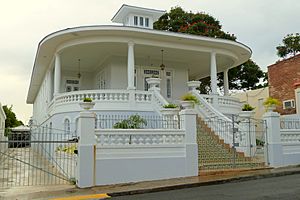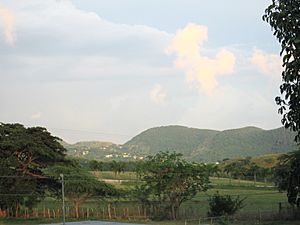Sabana Grande, Puerto Rico facts for kids
Quick facts for kids
Sabana Grande
Municipio de Sabana Grande
|
||
|---|---|---|
|
Town and Municipality
|
||

The historic Berta Sepúlveda House in Sabana Grande
|
||
|
||
| Nicknames:
"La Ciudad de los Petateros", "El Pueblo de los Prodigios" ("Town of Prodigies")
|
||
| Anthem: "Sabana Grande, ciudad petatera" | ||

Map of Puerto Rico highlighting Sabana Grande Municipality
|
||
| Sovereign state | ||
| Commonwealth | ||
| Settled | 1776 | |
| Founded | January 4, 1895 | |
| Founded by | Don Juan de la Torre | |
| Barrios | ||
| Area | ||
| • Total | 37.1 sq mi (96 km2) | |
| • Land | 37.1 sq mi (96 km2) | |
| • Water | 0.0 sq mi (0.0 km2) | |
| Population
(2020)
|
||
| • Total | 22,729 | |
| • Rank | 55th in Puerto Rico | |
| • Density | 612.6/sq mi (236.8/km2) | |
| Demonym(s) | Sabaneños | |
| Time zone | UTC−4 (AST) | |
| ZIP Code |
00637
|
|
| Area code(s) | 787/939 | |
| Major routes | ||
Sabana Grande is a town and municipality in Puerto Rico. It is located on the southwest side of the island. Sabana Grande is north of Lajas and Guánica. It is south of Maricao, east of San Germán, and west of Yauco.
The town is made up of seven areas called barrios. The main downtown area is called Sabana Grande Pueblo. Sabana Grande is also part of the San Germán-Cabo Rojo Metropolitan Statistical Area.
Contents
History of Sabana Grande
The name Sabana Grande means "big savanna" or "big plain" in Spanish. This name comes from the large flat area in the southern part of the municipality. This plain stretches west towards San Germán and Hormigueros. The word sabana comes from a Taíno word for plains.
Before 1808, there was already a community in the area. It even had its own church. This area was known as Sabana Grande Arriba, meaning "upper great savanna." At first, Sabana Grande was part of the larger municipality of San Germán.
Because the community was far from San Germán's center, people wanted their own church. They built a church dedicated to San Isidro Labrador and Santa María de la Cabeza. This church helped the San Germán parish.
How Towns Were Founded
During Spanish rule, founding a new town was a special process. A group of residents, called vecinos, would ask the governor for permission. They had to prove that their community was too far from an existing church or town services. They often showed that roads were bad or missing.
If the governor approved, a special official was appointed. The residents then had to build public places. These included a church, a government house, a slaughterhouse, and a cemetery. They also had to set aside land for a town square and common areas. Often, a landowner would donate land for the new town.
When Was Sabana Grande Founded?
There is some discussion about the exact founding date of Sabana Grande. Some say it was 1808, while others say 1813. Many historians agree that 1813 is the official founding year. This is because the first official record of a priest for the Sabana Grande Parish Church is from July 1, 1813. Before this, priests were listed as helping the San Germán church.
Sabana Grande became its own independent church area in June 1813. Martín Antonio Borreli was its first parish priest. On December 21, 1814, Pedro de Acosta became the first captain general of Sabana Grande. Some say he donated land for the town's public buildings.
Early Families and Hurricane Maria
Many families were among the first to settle in Sabana Grande. These included the Vélez Borrero, García Almodóvar, and Acosta families. Also, families from Catalonia (Spain) and Greek immigrants settled here.
On September 20, 2017, Hurricane Maria hit Puerto Rico. The heavy rain caused many landslides in Sabana Grande.
Geography
Sabana Grande is located in the southwest part of Puerto Rico. It is in the Lajas Valley. Several rivers flow through the area. These include the Río Guanajibo, Coco River, Flores River, and Río Grande.
Barrios and Sectors
Like all municipalities in Puerto Rico, Sabana Grande is divided into areas called barrios. The main town area, with the municipal buildings and church, is called "el pueblo."
Barrios are further divided into smaller areas called sectores (sectors). These can have different names like urbanización or barriada.
Special Communities
Some communities in Puerto Rico are called Comunidades Especiales (Special Communities). These are areas where people might face challenges like social exclusion. In 2014, some areas in Sabana Grande were on this list. These included Santana, Cerro Gordo, El Burén, Molinas, and Susúa.
Economy
The economy of Sabana Grande includes small-scale agriculture. Farmers grow fruits and sugar. They also raise cattle.
Population Data
| Historical population | |||
|---|---|---|---|
| Census | Pop. | %± | |
| 1900 | 10,560 | — | |
| 1910 | 11,523 | 9.1% | |
| 1920 | 12,305 | 6.8% | |
| 1930 | 11,881 | −3.4% | |
| 1940 | 14,146 | 19.1% | |
| 1950 | 16,097 | 13.8% | |
| 1960 | 15,910 | −1.2% | |
| 1970 | 16,343 | 2.7% | |
| 1980 | 20,207 | 23.6% | |
| 1990 | 22,843 | 13.0% | |
| 2000 | 25,935 | 13.5% | |
| 2010 | 25,265 | −2.6% | |
| 2020 | 22,729 | −10.0% | |
| U.S. Decennial Census 1899 (shown as 1900) 1910-1930 1930-1950 1960-2000 2010 2020 |
|||
Tourism
Places to Visit
Sabana Grande has several interesting places to visit:
- San Francisco Estate: This is a historic sugar mill complex. It includes an old estate house. It is listed on the National Register of Historic Places.
- Museum of Art: This museum is located inside the City Hall building.
- The Sanctuary of the Virgin of the Rosary of the Well (El Pozo de la Virgen): This is a Catholic mission. It has many members around the world.
- Susúa State Forest: A beautiful forest area for nature lovers.
- Barco House (Casa Barco): Another historic building in the town.
- Orlando López Recreational Center: A place for fun and activities.
- Igualdad Lodge #23: A historic meeting place for Freemasons.
- Masonic Cemetery: This cemetery is important for its history. It shows the struggles between the Spanish government and the Catholic Church against Freemasons in the 1800s.
- Placita de la Recordación: A small square for remembrance.
Culture
Festivals and Events
Sabana Grande celebrates its patron saint festival in May. This is called the Fiestas Patronales de San Isidro Labrador. It is a religious and cultural event. It usually has parades, games, local crafts, rides, food, and live music.
Other festivals and events in Sabana Grande include:
- Virgen del Pozo Marathon – May
- Inter-organizational Carnival – April
- Soberao Jazz Festival – April
- Petate Festival – December
- Burén Corn Fritter Festival – December
- Troubadour Festival – December
- Three Kings Festival – January
- Grand Petate Festival – February
Transportation
Sabana Grande has 27 bridges. The main highways that go through Sabana Grande are PR-2, PR-120, PR-121, PR-102, and PR-117. In 2020, a part of PR-368 was named Fidel Vélez Vélez.
Symbols
The municipality of Sabana Grande has an official flag and a coat of arms.
Flag
The flag of Sabana Grande has four squares. Two are green and two are yellow, placed in an alternating pattern. In the middle of the flag is the municipal coat of arms. The flag's design and meaning come from the coat of arms.
Coat of Arms
The coat of arms of Sabana Grande shows symbols related to the town's patron saints. The shovel and rake represent San Isidro Labrador. This symbol comes from the faith of the farmers in Sabana Grande. They prayed to their patron saint during droughts to save their crops. The urn represents the home duties of Santa María de la Cabeza, who was San Isidro's wife.
In the center, there is a leaf from the petate palm. This leaf is a symbol of a traditional industry in Sabana Grande. Above the shield is a crown wall. This represents unity and defense, a common symbol in town coats of arms. The motto on the coat of arms is "Town of the Prodigies."
Education
Sabana Grande has several public and private schools. The Puerto Rico Department of Education manages the public schools.
Some of the local schools are:
- Jose A. Castillo Elementary
- Jose Celso Barbosa Elementary
- Rosendo Matienzo Cintron Elementary
- Francisco Vazquez Puello Elementary
- David Antorgiorgi Cordova Elementary and Middle School
- Juan I. Vega Elementary and Middle School
- Blanca Malaret Middle School
- Luis Negron Lopez High School
- Jose R Gaztambide Elementary
Private schools include:
- The Academy of Saint Agustin and the Holy Spirit
- Santa Ana Bilingual School
- Christian Academy
- Baptist Academy
- Seventh-Day Adventist Academy
Notable People from Sabana Grande
Many famous people are from Sabana Grande, also known as Sabaneños:
- Luis Negrón López (a politician)
- Santos Colón (a singer)
- Félix Rigau Carrera (the first Puerto Rican pilot and the first to fly air mail in Puerto Rico)
- Aníbal González Irizarry (an educator, journalist, and news broadcaster)
- Adalberto Rodríguez "Machuchal" (a comedian)
- Fidel Vélez Vélez (a patriot involved in the Intentona de Yauco)
- John Ruiz (the first Hispanic Heavyweight World Champion in boxing)
- Jose Vidro (an MLB All-Star baseball player)
- Jonathan Sánchez (an MLB Pitcher, who threw a No Hitter and won a World Series)
See also
 In Spanish: Sabana Grande (Puerto Rico) para niños
In Spanish: Sabana Grande (Puerto Rico) para niños



